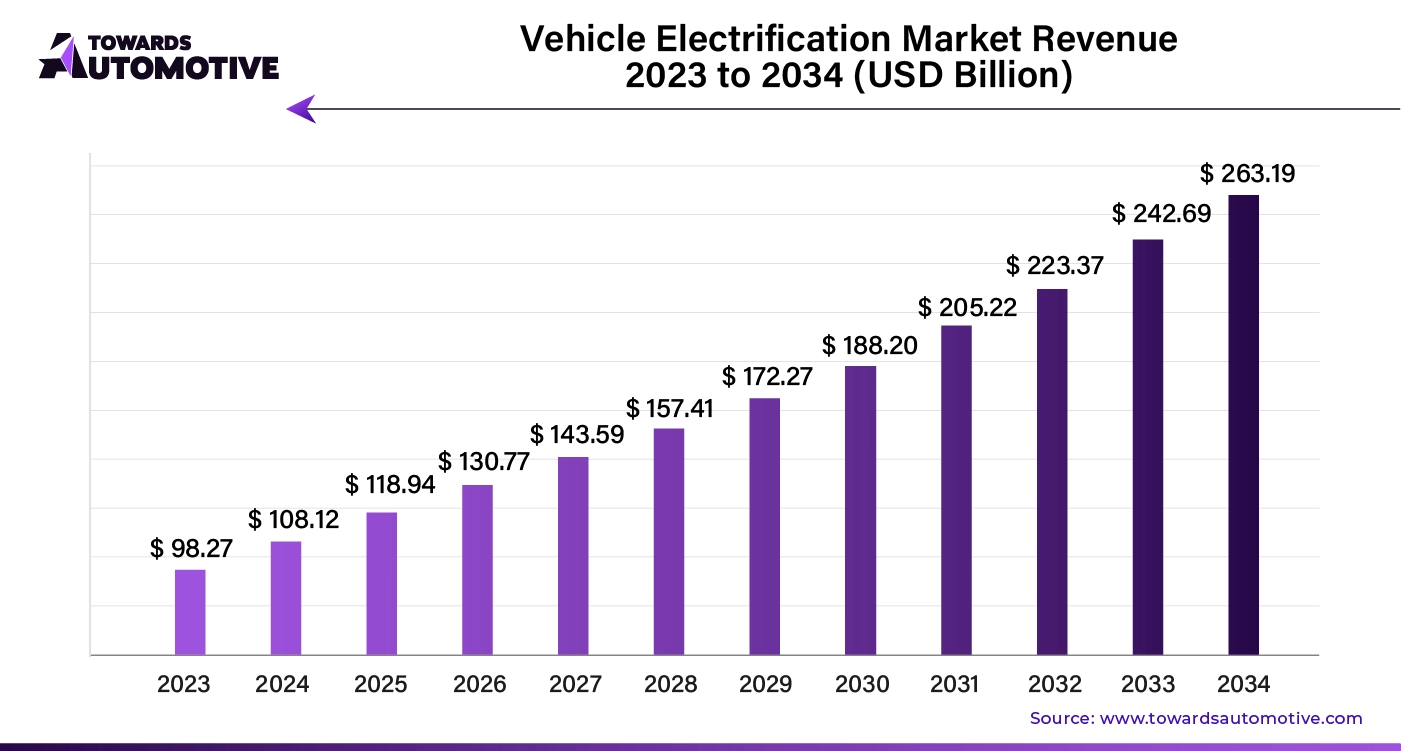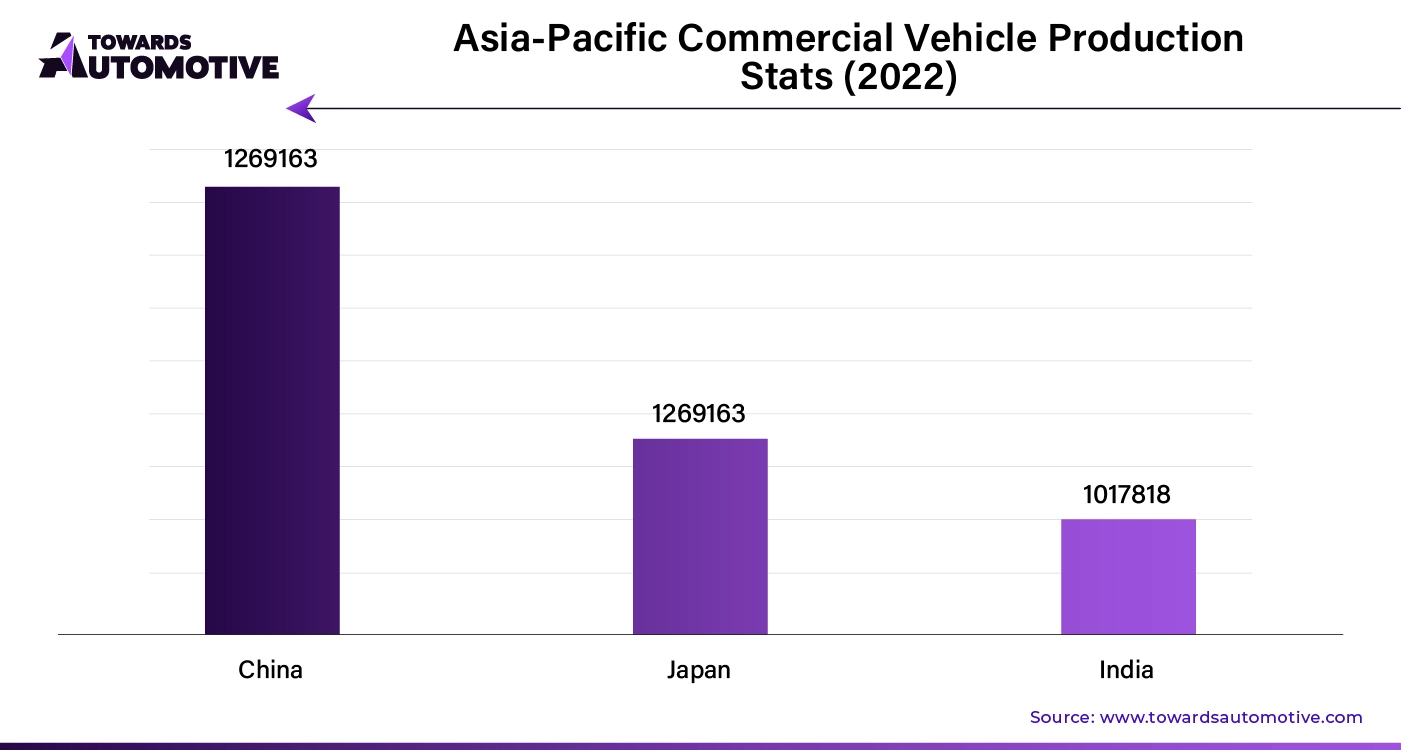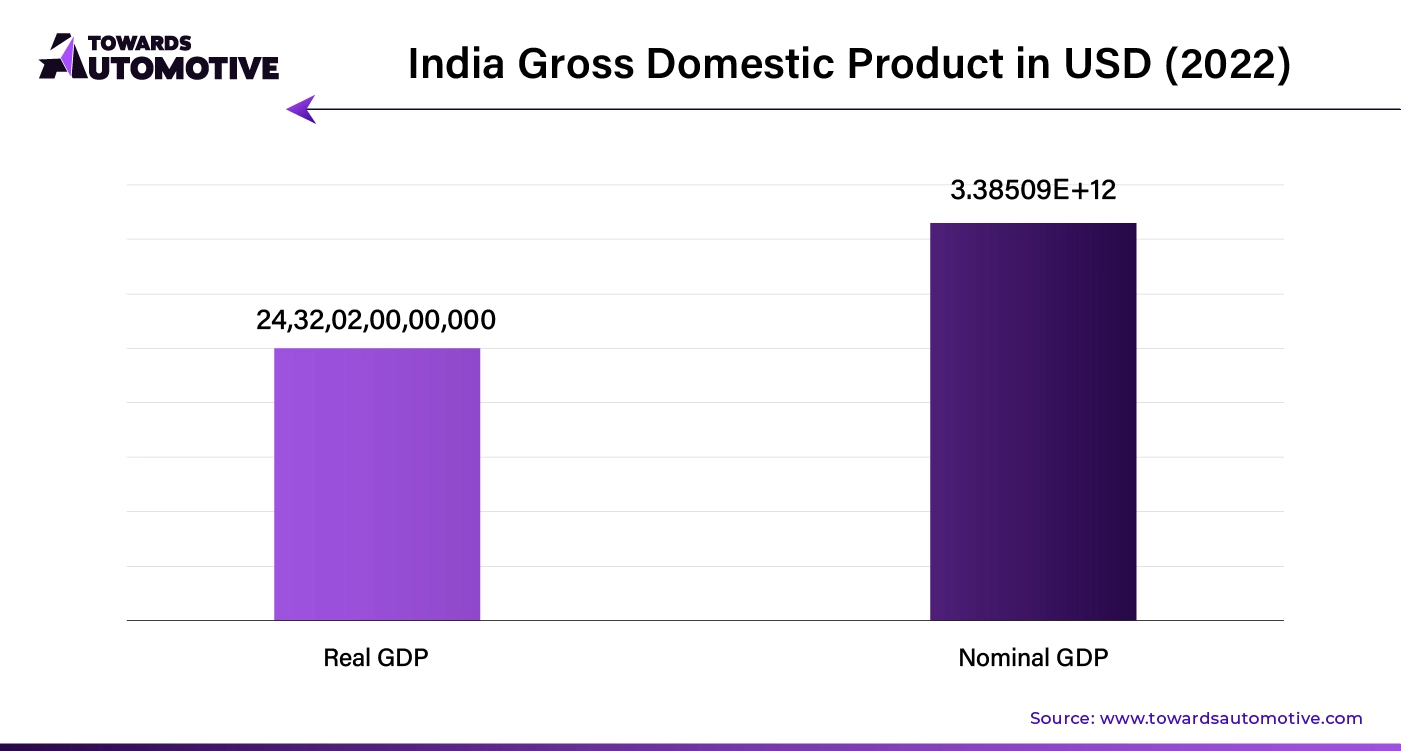February 2025
The global vehicle electrification market size is calculated at USD 108.12 billion in 2024 and is expected to be worth USD 263.19 billion by 2034, expanding at a CAGR of 9.93% from 2024 to 2034.

Unlock Infinite Advantages: Subscribe to Annual Membership
The vehicle electrification market is gaining momentum as the global shift towards cleaner and more sustainable transportation accelerates. With growing concerns over climate change and government mandates to reduce carbon emissions, automakers and consumers alike are turning to electric solutions to replace traditional internal combustion engine (ICE) vehicles. This market spans a wide range of technologies, including battery electric vehicles (BEVs), hybrid electric vehicles (HEVs), and plug-in hybrid vehicles (PHEVs), as well as key components such as electric motors, advanced batteries, and charging infrastructure.
Innovations in battery technology, combined with falling production costs and the expansion of charging networks, are driving the adoption of electric vehicles (EVs) across various segments, from passenger cars to commercial fleets. Government incentives, such as subsidies and tax benefits, are further bolstering market growth by making EVs more accessible. In addition, corporate sustainability goals are pushing fleet operators to electrify their operations, contributing to increased demand.
As consumer awareness about environmental issues continues to rise, the vehicle electrification market is expected to experience sustained growth, reshaping the future of mobility and offering significant opportunities for automakers, technology providers, and infrastructure developers worldwide.
AI plays a pivotal role in accelerating the growth of the vehicle electrification market by enhancing performance, efficiency, and user experience. One of the primary applications of AI is in optimizing battery management systems (BMS) for electric vehicles (EVs). AI algorithms analyze vast amounts of data in real-time to manage charging cycles, predict battery health, and optimize energy consumption, extending battery life and improving overall efficiency. This helps overcome key barriers to EV adoption, such as range anxiety and long charging times.
Additionally, AI supports advanced predictive maintenance by monitoring vehicle components and identifying potential issues before they lead to costly repairs or breakdowns. This reduces operational costs and downtime, making EVs more appealing to fleet operators and individual consumers.
AI also enhances driving experience through smart features like autonomous driving, advanced driver assistance systems (ADAS), and energy-efficient route planning, further boosting the appeal of electric vehicles. By integrating AI with electric vehicle infrastructure, such as smart grids and charging stations, vehicles can automatically choose optimal charging times based on electricity demand, reducing grid stress and lowering energy costs.
The increasing demand for commercial vehicles is a significant driver of growth in the vehicle electrification market. As industries such as logistics, e-commerce, and public transportation expand, the need for efficient, cost-effective, and sustainable vehicles is becoming more critical. Electric commercial vehicles (ECVs), including trucks, buses, and delivery vans, offer a solution to rising fuel costs and stringent emissions regulations, making them an attractive option for fleet operators. The electrification of commercial fleets reduces operating expenses, particularly in fuel and maintenance, while helping companies meet environmental and sustainability goals.
Governments worldwide are offering incentives and imposing stricter emissions standards to encourage the adoption of electric commercial vehicles. This regulatory support, combined with advancements in battery technology and charging infrastructure, is accelerating the shift towards electric fleets. As more companies invest in electric vehicles for their operations, the demand for essential components such as electric motors, powertrains, and batteries is expected to rise, further boosting the vehicle electrification market.
Additionally, the need for long-range electric commercial vehicles is driving innovation, pushing manufacturers to develop higher-capacity batteries and more efficient electric drivetrains. This trend is set to reshape the commercial vehicle sector and fuel sustained growth in the broader electrification market.

The vehicle electrification market faces several restraints despite its growth potential. High production costs, primarily driven by expensive battery technology, remain a significant challenge, making electric vehicles (EVs) less affordable for many consumers. Additionally, limited charging infrastructure and concerns over range anxiety hinder widespread EV adoption. Supply chain disruptions, particularly in sourcing key raw materials like lithium and cobalt, further complicate market expansion. Lastly, the transition from internal combustion engines (ICEs) to electric vehicles requires substantial investment, posing financial challenges for automakers and fleet operators.
Wireless battery technology is creating new opportunities in the vehicle electrification market by enhancing convenience, efficiency, and user experience. Traditional charging methods require physical connections, which can be inconvenient and time-consuming. Wireless charging, however, eliminates the need for cables and connectors, allowing electric vehicles (EVs) to charge simply by parking over a charging pad. This seamless process reduces the effort required for regular charging, promoting greater EV adoption among consumers and fleet operators.
In commercial applications, wireless charging offers particular benefits by streamlining operations for electric buses, taxis, and delivery vehicles. With wireless technology, vehicles can charge during brief stops, such as at traffic lights or during loading/unloading, optimizing energy use and minimizing downtime.
Additionally, the development of dynamic wireless charging, where EVs can charge while driving, could revolutionize long-distance travel and further reduce range anxiety, a common concern among potential EV buyers. As wireless technology becomes more advanced and widespread, it presents significant growth opportunities for automakers, infrastructure developers, and technology companies, contributing to the broader expansion of the vehicle electrification market. This innovation is set to play a crucial role in enhancing the viability and attractiveness of electric vehicles in the coming years.
The passenger vehicle segment held the largest share of the market. Passenger vehicles are a key driver of growth in the vehicle electrification market, as consumer demand for sustainable and cost-effective transportation continues to rise. With growing awareness of environmental issues and stricter emissions regulations, many car buyers are opting for electric vehicles (EVs) over traditional internal combustion engine (ICE) vehicles. Automakers are responding to this shift by expanding their portfolios to include a variety of electric models, from compact cars to luxury sedans and SUVs, catering to a wide range of consumer preferences.
Advancements in battery technology, which have led to improved driving range and faster charging times, are making electric passenger vehicles more practical and appealing. Additionally, government incentives, such as tax credits and rebates, are making EVs more affordable, further driving market growth. The expansion of charging infrastructure also supports this trend, reducing range anxiety and increasing the convenience of owning an electric vehicle.
As the market for passenger EVs grows, it creates opportunities for automakers, battery manufacturers, and charging infrastructure developers to capitalize on the increasing demand. This surge in passenger vehicle electrification is expected to play a significant role in the future of sustainable transportation.
The internal combustion engine (ICE) segment led the market. Internal combustion engine (ICE) vehicles play an unexpected role in driving the growth of the vehicle electrification market. As ICE technology becomes subject to stricter emissions regulations, automakers are increasingly incorporating hybrid powertrains that combine electric motors with traditional ICE systems. These hybrid vehicles serve as a transitional technology, appealing to consumers who seek improved fuel efficiency and lower emissions without fully committing to electric vehicles (EVs).
Moreover, the push to meet global environmental targets has spurred innovations in ICE technology, which in turn influences advancements in electric powertrains. As companies strive to reduce emissions from conventional vehicles, they are also investing heavily in research and development (R&D) for EV components such as electric motors, batteries, and charging infrastructure.
Additionally, the infrastructure and expertise developed around ICE manufacturing are being adapted to support the production of hybrid and electric vehicles, creating a bridge between traditional and electric mobility. This gradual shift allows automakers to meet current market demands while preparing for a fully electrified future, with ICE vehicles playing a crucial role in propelling the growth of the broader vehicle electrification market during the transition phase.
The electric vacuum pump segment is the highest contributor in the industry. Electric vacuum pumps (EVPs) play a crucial role in driving the growth of the vehicle electrification market by improving the efficiency along with performance of electric vehicles (EVs) and hybrid vehicles. Traditional internal combustion engine (ICE) vehicles rely on engine vacuum for braking systems and other functions. However, in fully electric and hybrid vehicles, the absence or reduced operation of the ICE means a different vacuum source is needed. Electric vacuum pumps provide this vacuum, ensuring consistent braking performance and safety in EVs.
By enhancing the performance of braking systems, EVPs contribute to better energy management, as they only operate when needed, unlike mechanical pumps that are continuously driven by the engine. This energy efficiency aligns with the goals of vehicle electrification, where reducing energy waste is key to extending range and improving vehicle performance.
As the demand for electric and hybrid vehicles grows, so does the need for EVPs, creating opportunities for component manufacturers and system integrators. The ability of electric vacuum pumps to support critical vehicle functions while improving overall efficiency makes them an essential component, driving growth and innovation within the vehicle electrification market.
Asia Pacific dominated the vehicle electrification market. In the Asia Pacific region, rapid urbanization, a supportive industrial ecosystem, and robust economic growth are pivotal in driving the growth of the vehicle electrification market. As cities across Asia Pacific expand and modernize, there is an increasing demand for sustainable transportation solutions to address pollution and traffic congestion. Electric vehicles (EVs) offer a cleaner alternative to traditional internal combustion engines, aligning with urban development goals focused on improving air quality and reducing environmental impact.
The region's supportive industrial ecosystem further accelerates market growth by fostering innovation and production of electric vehicle technologies. Major automotive manufacturers and technology firms are investing in the development of advanced electric powertrains, battery technologies, and charging infrastructure. This collaborative environment not only enhances technological capabilities but also ensures the availability of high-quality EV components and vehicles.
Economic growth in Asia Pacific contributes to the expansion of the vehicle electrification market by increasing disposable incomes and making EVs more accessible to consumers. As economies advance and living standards rise, the demand for electric vehicles grows, supported by favorable government policies and incentives. Together, these factors create a dynamic environment that drives the adoption of electric vehicles and supports the transition to sustainable transportation in the Asia Pacific region.

North America is expected to grow with the highest CAGR during the forecast period. In North America, the growth of the vehicle electrification market is being significantly propelled by a combination of government policies and incentives, investment in charging infrastructure, technological advancements, and rising consumer demand and awareness. Government initiatives play a crucial role, with various federal and state policies offering substantial tax credits, rebates, and grants to both consumers and manufacturers. These incentives not only make electric vehicles (EVs) more financially accessible but also align with broader environmental goals aimed at reducing greenhouse gas emissions and promoting clean energy.
Investment in EV charging infrastructure is another critical driver. The expansion of fast-charging networks and the development of accessible public and home charging solutions address range anxiety and convenience issues, which are pivotal in encouraging broader EV adoption. Enhanced infrastructure ensures that consumers and fleet operators can charge their vehicles efficiently, supporting the transition to electric mobility.
Technological advancements further fuel market growth by improving the performance and affordability of electric vehicles. Innovations in battery technology, such as increased energy density and faster charging capabilities, make EVs more practical and competitive with traditional internal combustion engine vehicles.
Consumer demand and awareness are also on the rise, driven by growing environmental consciousness and the benefits of lower operating costs associated with EVs. As more people become informed about the advantages of electric vehicles, their adoption continues to increase, creating a dynamic and expanding market for vehicle electrification in North America.
By Product
By Hybridization
By Vehicle Type
By Region
February 2025
February 2025
February 2025
February 2025
Dr. Arjun Patel is a distinguished expert in the automotive industry, holding advanced degrees in Automotive Engineering and Mechanical Engineering. His expertise spans automotive market dynamics, technological advancements, and sustainable practices. Dr. Patel excels in conducting in depth research and analysis on market trends, consumer preferences, and the economic implications within the automotive sector. He is renowned for his insightful publications on topics such as electric vehicles, autonomous driving technologies, and the evolution of sustainable transportation solutions. Dr. Patels research contributions have significantly advanced understanding in the field, earning him recognition as a leading authority in automotive research and analysis.
We offer automotive expertise for market projections and customizable research, adaptable to diverse strategic approaches.
Contact Us